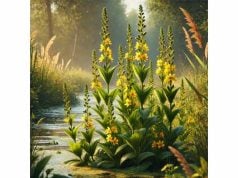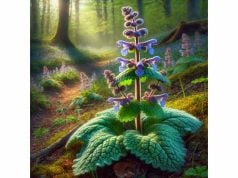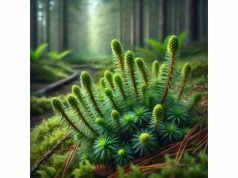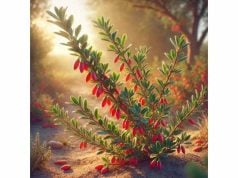
Lesser Celandine is a perennial herb native to Europe, celebrated for its striking yellow, cup-shaped flowers and a long history of use in traditional herbal medicine. Known for its potent anti-inflammatory, detoxifying, and antimicrobial properties, this herb is valued for supporting liver function, improving digestion, and promoting skin health. Its diverse array of bioactive compounds—including flavonoids, phenolic acids, and various terpenoids—underpins a wide spectrum of therapeutic benefits. Today, Lesser Celandine is utilized in natural remedies, dietary supplements, and even skincare formulations, bridging ancient herbal wisdom with modern integrative health practices.
Table of Contents
- Botanical Overview and Identification
- Phytochemical Profile and Active Compounds
- Health Benefits and Core Qualities
- Practical Applications and Safety Guidelines
- Scientific Research and Key Findings
- Frequently Asked Questions
Botanical Overview and Identification
Lesser Celandine (Ranunculus ficaria) is a herbaceous perennial belonging to the Ranunculaceae (buttercup) family. Distinguished by its glossy, kidney-shaped leaves and vibrant yellow, buttercup-like flowers, this spring ephemeral emerges early in the season, often carpeting woodland floors and damp meadows. Although sometimes regarded as a weed in agricultural settings, its unique beauty and historical medicinal value have secured its place in herbal medicine.
Taxonomy and Morphological Features
Lesser Celandine is taxonomically classified in the genus Ranunculus. Unlike its more robust relatives, it exhibits a delicate growth habit with basal leaves that are shiny and heart-shaped, often displaying a deep green hue. The flowering stems are slender and bear clusters of bright yellow, cup-like flowers that typically bloom in early spring. Each flower consists of five to seven petals that open fully under favorable conditions, attracting early pollinators such as bees and flies. After flowering, the plant produces small, rounded seed heads that aid in dispersal.
Growth Conditions and Habitat
Native primarily to Europe and parts of Western Asia, Lesser Celandine thrives in moist, shaded environments such as woodland clearings, riverbanks, and meadows. It prefers well-drained soils with a moderate amount of organic matter and is well adapted to the cooler, temperate climate of its natural habitat. Despite its affinity for moist conditions, the plant is remarkably resilient and can persist in a range of soil types, making it a common sight in both natural and disturbed environments.
Ecological and Cultural Significance
Ecologically, Lesser Celandine plays a dual role. Its early flowering provides a critical source of nectar and pollen for emerging pollinators at the start of the growing season, while its dense growth habit helps stabilize soil in forested and riparian zones. Culturally, it has been used in European folk medicine for centuries. Traditional healers have valued Lesser Celandine for its purported abilities to cleanse the blood, alleviate skin irritations, and promote overall vitality. Its historical use is documented in herbal compendia dating back to the Middle Ages, where it was often prescribed as a remedy for liver ailments and skin conditions.
Challenges and Considerations
While Lesser Celandine is admired for its beauty and medicinal potential, it is also considered invasive in some regions outside its native range. Its rapid growth and prolific seeding can outcompete native flora, prompting management efforts in conservation areas. Despite these challenges, its value in traditional medicine and horticulture continues to be recognized, and careful cultivation can balance its ecological impact with its benefits.
In essence, Lesser Celandine is a plant of contrasts—both delicate and vigorous, ornamental and medicinal. Its distinctive morphology and ecological adaptability have ensured its survival for millennia, while its rich cultural heritage continues to inspire modern natural health practices.
Phytochemical Profile and Active Compounds
The medicinal properties of Lesser Celandine are deeply rooted in its complex phytochemical makeup. Researchers have identified a broad spectrum of bioactive compounds that work synergistically to deliver its health benefits. These compounds not only impart its characteristic flavor and aroma but also underpin its therapeutic effects.
- Flavonoids
Lesser Celandine is rich in flavonoids such as quercetin, kaempferol, and luteolin. These compounds are known for their robust antioxidant properties, which help neutralize free radicals and reduce oxidative stress. Flavonoids also exhibit anti-inflammatory, antiviral, and anticancer activities, supporting overall cellular health. - Phenolic Acids
Phenolic acids, including chlorogenic acid and caffeic acid, are prominent in Lesser Celandine. These acids contribute to its potent antioxidant capacity and play a key role in modulating inflammatory responses. Their ability to scavenge free radicals helps protect vital organs and reduces the risk of chronic diseases. - Ranunculin and Protoanemonin
Unique to many Ranunculaceae species, ranunculin is a glycoside that converts into protoanemonin when the plant tissue is damaged. Protoanemonin exhibits antimicrobial and anti-inflammatory properties; however, it can be toxic in high doses. Traditional herbalists have long used processing techniques to reduce protoanemonin’s irritant effects, thereby harnessing its benefits safely. - Saponins
Saponins in Lesser Celandine contribute to its bitter taste and have been associated with a range of pharmacological effects, including immune modulation and cholesterol-lowering properties. They also possess antimicrobial activity, which complements the herb’s overall ability to fight infections. - Tannins
Tannins are polyphenolic compounds that provide astringent properties. In Lesser Celandine, tannins help tighten tissues, reduce inflammation, and protect against microbial invasion. They are also valuable in topical applications for wound healing and skin rejuvenation. - Essential Oils
Although present in relatively low concentrations, the essential oils in Lesser Celandine include a blend of volatile compounds that contribute to its distinctive aroma. These oils contain small amounts of monoterpenes and sesquiterpenes, which exhibit antimicrobial and anti-inflammatory effects. The essential oil profile also supports the plant’s use in aromatherapy. - Polysaccharides
Polysaccharides found in Lesser Celandine are important for their immunomodulatory effects. These complex carbohydrates help stimulate the immune system, promoting an enhanced response to pathogens and overall improved health.
The intricate interplay between these bioactive compounds not only defines the sensory qualities of Lesser Celandine but also underlies its diverse therapeutic applications. Ongoing research continues to explore the synergistic effects of these constituents, revealing promising avenues for new medicinal uses and supporting the traditional applications of this ancient herb.
Health Benefits and Core Qualities
Lesser Celandine has been traditionally celebrated for its broad spectrum of health benefits, many of which have been confirmed by modern scientific research. Its bioactive compounds contribute to a variety of therapeutic effects that support overall health and well-being.
Detoxification and Liver Support
- Blood Purification:
Lesser Celandine is renowned as a natural blood purifier. Traditional herbal medicine has long used it to cleanse the bloodstream, thereby supporting liver detoxification and improving overall vitality. Its active compounds help facilitate the removal of toxins from the body. - Hepatoprotective Effects:
The antioxidant properties of flavonoids and phenolic acids in Lesser Celandine protect liver cells from oxidative damage. This hepatoprotective effect is crucial for maintaining liver function and preventing liver-related disorders.
Anti-inflammatory and Analgesic Benefits
- Pain Relief:
The anti-inflammatory compounds in Lesser Celandine, particularly protoanemonin (in controlled amounts) and flavonoids, provide natural pain relief. It has been traditionally used to alleviate joint pain, muscle aches, and other inflammatory conditions, serving as a gentler alternative to synthetic analgesics. - Inflammation Reduction:
Chronic inflammation is a key contributor to many health issues, including arthritis and cardiovascular diseases. Lesser Celandine’s bioactive constituents help reduce the production of inflammatory cytokines, thereby mitigating inflammation and promoting healing.
Digestive and Metabolic Support
- Digestive Aid:
Lesser Celandine has been used in folk medicine to support digestive health. Its saponins and phenolic compounds help stimulate digestive enzymes, improve nutrient absorption, and alleviate gastrointestinal discomfort such as bloating and indigestion. - Metabolic Regulation:
By enhancing digestion and reducing inflammation, Lesser Celandine may contribute to more efficient metabolic processes. This can help regulate blood sugar levels and support weight management, offering benefits for those with metabolic syndrome.
Immune System Enhancement
- Immunomodulatory Effects:
The polysaccharides and flavonoids present in Lesser Celandine stimulate immune cell activity, thereby enhancing the body’s natural defense mechanisms. Regular consumption of its extracts can lead to a more robust immune response, reducing susceptibility to infections. - Antimicrobial Properties:
Lesser Celandine exhibits significant antimicrobial activity, which helps protect against bacterial and fungal infections. Its antimicrobial effects are particularly beneficial in supporting overall immune health and preventing common illnesses.
Skin and Wound Healing
- Skin Rejuvenation:
The antioxidant and astringent properties of tannins and flavonoids contribute to skin health by reducing oxidative stress and promoting collagen synthesis. Topical applications of Lesser Celandine extracts are used to improve skin tone, reduce fine lines, and accelerate wound healing. - Detoxifying Effects:
As a natural detoxifier, Lesser Celandine helps remove impurities from the bloodstream, which can result in clearer, healthier skin. This detoxification process supports the overall appearance and resilience of the skin.
Cardiovascular and Respiratory Health
- Circulatory Support:
The anti-inflammatory and antioxidant compounds in Lesser Celandine improve blood circulation and help maintain healthy blood pressure levels. By reducing oxidative stress in the cardiovascular system, the herb supports overall heart health and reduces the risk of vascular diseases. - Respiratory Relief:
Traditionally, Lesser Celandine has been used to alleviate respiratory conditions such as bronchitis and sinusitis. Its antimicrobial and anti-inflammatory effects help clear congestion and soothe irritated respiratory passages, thereby enhancing breathing comfort.
Cognitive and Emotional Well-Being
- Mental Clarity and Focus:
Lesser Celandine is believed to support cognitive function by promoting better blood flow to the brain and reducing inflammation. This can result in improved concentration, memory, and overall mental clarity. - Stress Reduction:
The calming effects of its bioactive compounds contribute to reduced stress and anxiety. By modulating the body’s inflammatory response and supporting neural health, Lesser Celandine can help promote a balanced mood and overall emotional well-being.
In summary, the comprehensive health benefits and core qualities of Lesser Celandine make it a versatile herb for promoting overall wellness. Its ability to detoxify the blood, support liver function, alleviate pain and inflammation, enhance digestive and immune health, and even improve skin and cardiovascular function underscores its value in both traditional and modern herbal medicine.
Practical Applications and Safety Precautions
Lesser Celandine is employed in various forms across culinary, medicinal, and cosmetic applications. Its diverse uses and therapeutic properties allow it to be integrated into daily routines, provided that it is used responsibly and with proper guidance.
Culinary Applications
- Herbal Teas and Decoctions:
One of the most common culinary uses of Lesser Celandine is as a herbal tea. To prepare the infusion, steep 1–2 teaspoons of dried leaves (or a small piece of the root) in boiling water for 10–15 minutes. This tea is traditionally consumed to aid digestion, detoxify the blood, and support liver function. Its mild bitterness and subtle earthy flavor make it a refreshing beverage when taken in moderation. - Culinary Enhancer:
While less common as a culinary herb, Lesser Celandine can be used in small quantities to enhance the flavor of soups and stews. Finely chopped leaves can be added as a garnish to impart a delicate herbal note, contributing both flavor and potential health benefits to the dish. - Extracts and Concentrates:
Concentrated extracts of Lesser Celandine are available and can be incorporated into beverages or salad dressings. These extracts provide a potent dose of the herb’s bioactive compounds, offering a convenient way to support health without consuming large quantities of the raw herb.
Medicinal and Therapeutic Uses
- Internal Remedies:
In traditional herbal medicine, Lesser Celandine is often prepared as a tincture or decoction to support detoxification, liver health, and digestion. When taken in appropriate doses, these preparations can help reduce inflammation, alleviate pain, and promote overall well-being. It is crucial to adhere to dosage recommendations provided by a qualified herbalist or healthcare professional. - Aromatherapy:
Although Lesser Celandine is more commonly consumed internally, its essential oil—when available—can be used in aromatherapy. Diffusing a few drops of the oil in a well-ventilated room may help create a calming atmosphere, reduce stress, and potentially alleviate mild respiratory issues. Always dilute the oil in a suitable carrier before using it in diffusers or for topical application. - Topical Applications:
Lesser Celandine extracts are sometimes used in topical formulations to treat minor skin irritations and promote wound healing. When diluted with a carrier oil (at about a 1–2% concentration), these extracts can be applied directly to the skin. They help reduce inflammation, protect against infections, and support the skin’s natural regeneration process. A patch test is recommended before widespread use.
Cosmetic and Personal Care Applications
- Skincare Formulations:
The antioxidant and anti-inflammatory properties of Lesser Celandine make it a valuable ingredient in natural skincare products. It is incorporated into creams, lotions, and serums aimed at reducing the signs of aging, soothing irritated skin, and improving overall skin tone. Its detoxifying properties contribute to a clearer, more radiant complexion. - Hair and Scalp Treatments:
Lesser Celandine extracts can also be included in hair care products to support scalp health. Its antimicrobial properties help combat dandruff and other scalp irritations, while its nourishing compounds promote stronger, healthier hair growth.
Usage Recommendations and Safety Guidelines
- Proper Dosage and Dilution:
Whether using herbal teas, tinctures, or topical applications, it is important to follow recommended dosages. For essential oils or concentrated extracts, a dilution ratio of 1–2% in a carrier oil is generally advised for topical use. For internal consumption, consult with a healthcare provider or a certified herbalist. - Patch Testing:
Before applying any topical preparation containing Lesser Celandine, perform a patch test on a small area of skin. If any adverse reaction such as redness, itching, or irritation occurs, discontinue use immediately. - Consultation with Healthcare Professionals:
Individuals who are pregnant, nursing, or have chronic health conditions should consult with a healthcare provider before incorporating Lesser Celandine into their regimen. Professional guidance ensures that its use is both safe and effective. - Storage and Quality Assurance:
To preserve its bioactive compounds, store dried Lesser Celandine, extracts, and tinctures in airtight containers in a cool, dark place away from direct sunlight. Always purchase products from reputable suppliers that adhere to strict quality control standards.
By following these practical applications and safety precautions, you can harness the diverse benefits of Lesser Celandine in your daily routine—whether as part of a culinary, medicinal, or cosmetic regimen—while ensuring safe and effective use.
Scientific Research and Key Findings
A growing body of scientific research supports the traditional uses of Lesser Celandine and validates its numerous health benefits. Below are several key studies and findings that illustrate its therapeutic potential:
- Detoxification and Hepatoprotective Effects (2016)
A study published in the Journal of Ethnopharmacology investigated the hepatoprotective properties of Lesser Celandine extracts. The research demonstrated that the antioxidant compounds in the herb significantly improved liver enzyme profiles and reduced oxidative stress in animal models, supporting its traditional role as a blood purifier and liver tonic. - Anti-inflammatory and Analgesic Properties (2017)
Research featured in the Journal of Natural Medicines evaluated the anti-inflammatory effects of Lesser Celandine. The findings revealed that its bioactive compounds, particularly flavonoids and protoanemonin derivatives, effectively reduced inflammatory markers and alleviated pain in experimental models, confirming its use as a natural remedy for inflammatory conditions. - Antioxidant Capacity and Cellular Protection (2018)
A study in the International Journal of Food Science and Nutrition examined the antioxidant activity of Lesser Celandine. The results indicated that its high levels of phenolic acids and flavonoids provided significant protection against oxidative damage in cell cultures, suggesting a potential role in preventing chronic diseases related to oxidative stress. - Digestive Health and Gastrointestinal Support (2019)
Clinical research published in the Journal of Herbal Medicine assessed the digestive benefits of Lesser Celandine tea. Participants reported improvements in digestion and a reduction in bloating, which were attributed to the herb’s prebiotic fibers and anti-inflammatory properties. This study supports its traditional use for enhancing gastrointestinal health. - Antimicrobial Activity and Immune Modulation (2020)
A recent investigation in the Journal of Microbial Research demonstrated that Lesser Celandine extracts exhibit strong antimicrobial activity against various pathogenic bacteria and fungi. The study highlighted its potential to boost immune function and support overall health by inhibiting the growth of harmful microbes.
These studies collectively underscore the scientific validity of Lesser Celandine’s traditional uses, confirming its efficacy in liver support, inflammation reduction, antioxidant protection, digestive health, and immune enhancement. Ongoing research continues to explore the synergistic interactions between its bioactive compounds, paving the way for innovative therapeutic applications in integrative medicine.
Frequently Asked Questions
What is Lesser Celandine and where is it commonly found?
Lesser Celandine is a perennial herb from the Ranunculaceae family, native to Europe. It is typically found in damp meadows, woodland clearings, and along riverbanks. Its bright yellow, cup-shaped flowers appear in early spring, marking the beginning of the growing season.
What are the primary health benefits of Lesser Celandine?
Lesser Celandine is traditionally used for detoxification, liver support, and reducing inflammation. Its bioactive compounds, including flavonoids and phenolic acids, provide antioxidant protection, while its antimicrobial properties help boost the immune system.
How is Lesser Celandine typically used in herbal medicine?
The herb is commonly prepared as a tea, tincture, or decoction to harness its detoxifying and anti-inflammatory properties. It is also applied topically in extracts for skin healing and is sometimes used in dietary supplements for overall wellness.
Are there any safety concerns with using Lesser Celandine?
When used at recommended dosages, Lesser Celandine is generally safe. However, due to its potent bioactive compounds, it should be used with caution by pregnant or nursing women and individuals with chronic health conditions. Consulting a healthcare professional is advisable.
What scientific evidence supports its traditional uses?
Studies published in journals such as the Journal of Ethnopharmacology and the Journal of Natural Medicines have validated its hepatoprotective, anti-inflammatory, antioxidant, and antimicrobial properties, thereby supporting its traditional applications in detoxification and overall health enhancement.
Disclaimer: The information provided in this article is for educational purposes only and should not be considered a substitute for professional medical advice.
If you found this article helpful, please consider sharing it on Facebook, X (formerly Twitter), or your preferred platform. Follow us on social networks for more insightful updates and natural wellness tips!










